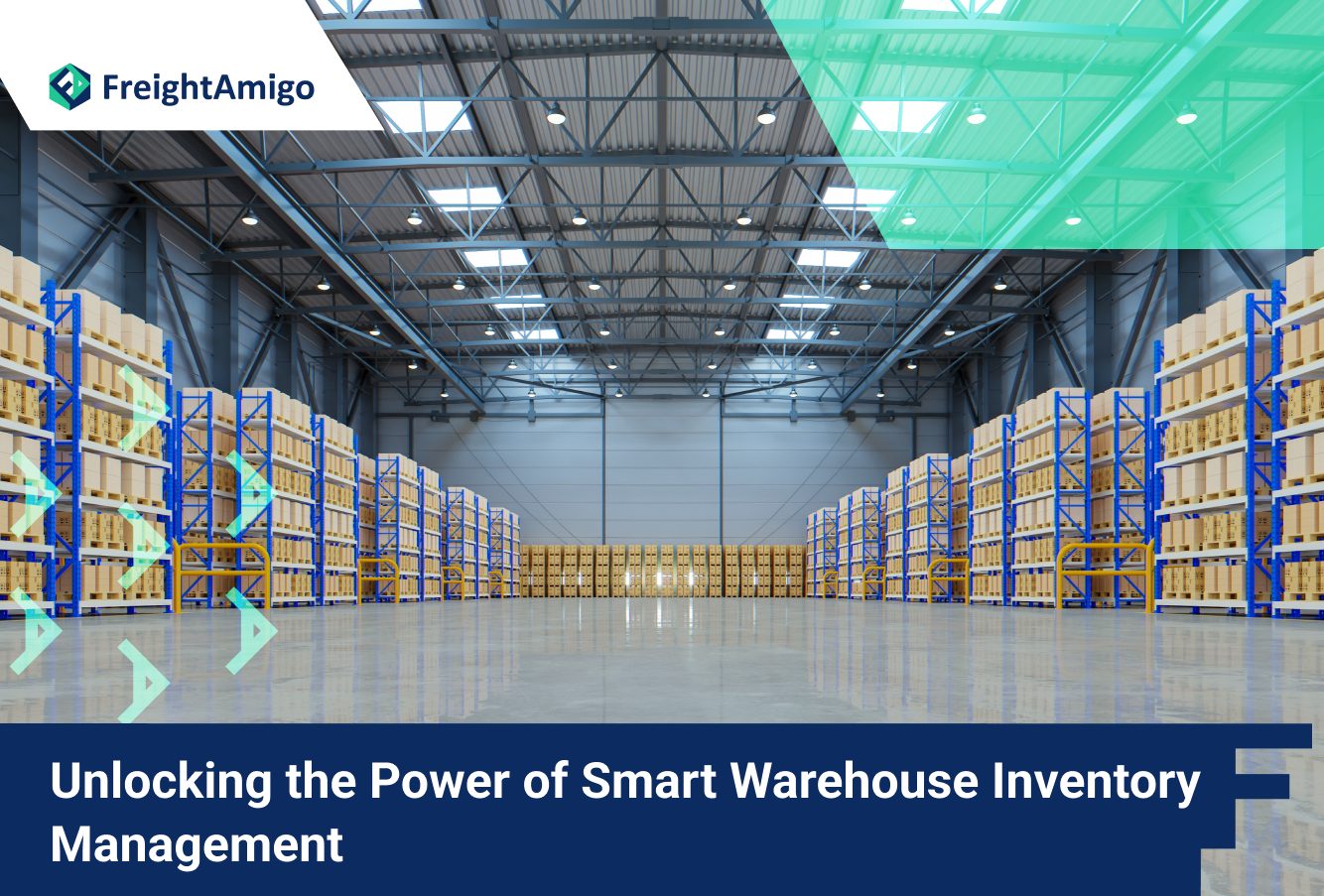Author Name: Aurora Park – Marketing Analyst at FreightAmigo
In today’s fast-paced business environment, supply chain managers understand the critical role that inventory management plays in ensuring operational efficiency and customer satisfaction. The advent of AI-powered visual recognition technology has revolutionized the way inventory is managed in warehouses, allowing for real-time stock management with unparalleled accuracy and transparency. In this comprehensive guide, we will explore the benefits of real-time inventory visibility and how it can optimize supply chain management.
Want to compare the best Express, Air Freight, Sea Freight, Rail Freight & Trucking rates so as to have better control on cost?
Benefits of Real-Time Inventory Visibility for Supply Chain Management
Inventory management automation is a significant challenge in supply chain management. Accurate and timely tracking of current stock status is crucial for organizations to meet customer demand while minimizing excess inventory and associated costs. Inaccurate inventory records and inefficient inventory management can lead to stockouts, delayed order fulfillment, reduced customer satisfaction, and decreased revenue. Furthermore, managing inventory becomes even more complex in global supply chains, where multiple locations, languages, and regulations must be taken into consideration. Therefore, efficient and effective inventory management is essential for successful supply chain operations and requires advanced technology and sophisticated processes.
Smart Resource Allocation
One of the key benefits of real-time inventory visibility is the ability to allocate resources effectively and automate the process. With accurate and timely insights, supply chain managers can prioritize high-demand items and ensure that resources are allocated to where they are needed the most. This not only improves operational efficiency but also helps in reducing costs associated with excess inventory or stock shortages.
Accurate Forecasting
Dynamic inventory monitoring enabled by real-time inventory visibility allows for accurate forecasting. By continuously tracking inbound and outbound stock and conducting regular stock audits, managers can better predict demand and expand distribution channels accordingly. This leads to better decision-making and helps avoid excess inventory and stock shortages, resulting in improved customer satisfaction.
Optimal Inventory Levels
Stock optimization is critical for supply chain management. With real-time inventory visibility, managers can ensure optimal stock levels by avoiding overstocking and stock shortages. This not only improves operational efficiency but also reduces the risk of inventory obsolescence. By aligning inventory levels with demand, supply chain managers can minimize holding costs and increase cash flow, allowing companies to invest in other areas of the business.
Inventory Visibility
Real-time inventory visibility provides complete visibility of stock levels, location, and movement. This helps managers track inventory in real-time and identify any issues before they become problems. By having accurate information on order fulfillment status, supply chain managers can improve customer satisfaction and build brand loyalty.
Increased ROI
With optimized inventory levels, supply chain managers can reduce inventory holding costs and increase cash flow. This allows companies to invest in other areas of the business, such as research and development or marketing initiatives. By maximizing return on investment (ROI) in inventory management, businesses can improve their overall financial performance.
Increased Demand Fulfillment
Efficient inventory management automation ensures that popular items are always in stock to meet customer demand. Accurate information about fulfillment schedules improves the customer experience and helps build brand loyalty. By consistently fulfilling customer orders on time, businesses can increase customer satisfaction and gain a competitive edge in the market.
AI in Warehouse Management
Automating a warehouse is a complex endeavor, but artificial intelligence (AI) can play a crucial role in transforming warehouse management. AI has already made significant impacts on various industries, including logistics and supply chain management. By harnessing AI’s power, warehouses can optimize processes, improve productivity, and enhance overall efficiency.
Sub-Technologies of AI in Warehouse Management
AI in the warehouse generates value through sub-technologies such as machine learning, natural language processing, robotics, and computer vision. Machine learning algorithms enable practical decision-making, optimizing inventory positioning, and recommending faster replenishment. Natural language processing enables voice-picking, while computer vision allows for automated barcode recognition and product tracking. Robotics gives AI a physical presence, enabling tasks like pallet loading, cargo movement, and picking operations.
Ways AI is Transforming Warehouse Management
- Productivity
Machine learning algorithms optimize pick-and-pack processes, integrating system-directed solutions and improving efficiency. By analyzing historical data and real-time information, AI can recommend the most efficient routes for order pickers, reducing travel time and increasing productivity.
- Communication
AI-powered automated systems facilitate faster and more accurate communication between different elements of the warehouse system. Through real-time data sharing and analysis, AI systems can provide instant updates on stock levels, order status, and any potential issues, enabling seamless coordination and collaboration.
- Labor Cost Reduction
While initial technological investment is required, AI has the potential to reduce labor costs as automation increases. By automating repetitive and mundane tasks, AI-powered robotics systems can free up human resources to focus on more complex and value-added activities. This not only reduces labor costs but also improves overall operational efficiency.
- Warehouse Logistics Optimization
AI optimizes logistics by reducing operator errors, improving processing times, and fine-tuning material handling. Through advanced algorithms and real-time data analysis, AI systems can optimize inventory placement, reducing the need for excessive material movement and improving overall warehouse efficiency.
- Data Analysis
Machine learning unlocks insights from supply chain data, improving collaboration, logistics, and warehouse management. By analyzing historical data and identifying patterns, AI can provide valuable insights into demand forecasting, inventory optimization, and overall supply chain performance. This data-driven approach helps supply chain managers make informed decisions and continuously improve warehouse operations.
- Inventory Control
AI-powered solutions such as RFID enable precise and accurate inventory control, optimizing resource allocation. By automatically tracking and updating inventory levels, AI systems can minimize stockouts and overstocking, reducing carrying costs and improving overall inventory management.
Conclusion
The integration of AI into warehouse management has the potential to revolutionize the industry by improving efficiency, safety, and cost-effectiveness. Companies that embrace AI technologies can benefit from improved communication, increased productivity, better data analysis, a safer workplace, simplified inventory management, cost savings, and effective contingency planning. While AI may replace certain roles traditionally performed by humans, it also creates new opportunities for collaboration and innovation. Assessing current performance, planning for digital transformation, and embracing AI technologies will set the stage for a successful automated warehouse future.
There are different options for cargo transportation. If you want to choose the most convenient and suitable solution, it is best to have the full support of logistics experts! If you are planning to ship goods overseas, please go to the FreightAmigo page for inquiries.
===
Read More:
Robotic Warehouse | Ensuring Safety and Efficiency
Enhancing Inventory Management with Robotic Warehouses in Logistics
The Rise of Robotic Warehouses
===
If you have any inquiries on logistics/supply chain, feel free to contact FreightAmigo now:
Chat with us online OR
Phone : +852 28121686
WhatsApp: +852 27467829









































